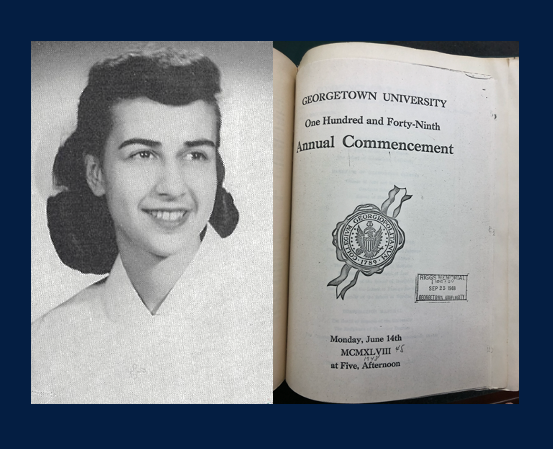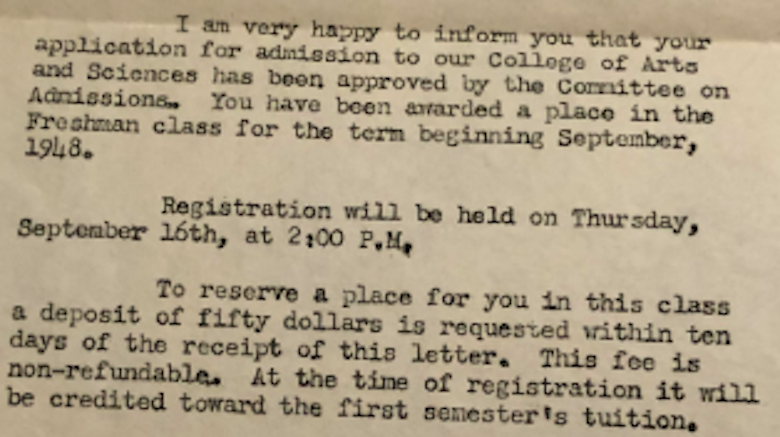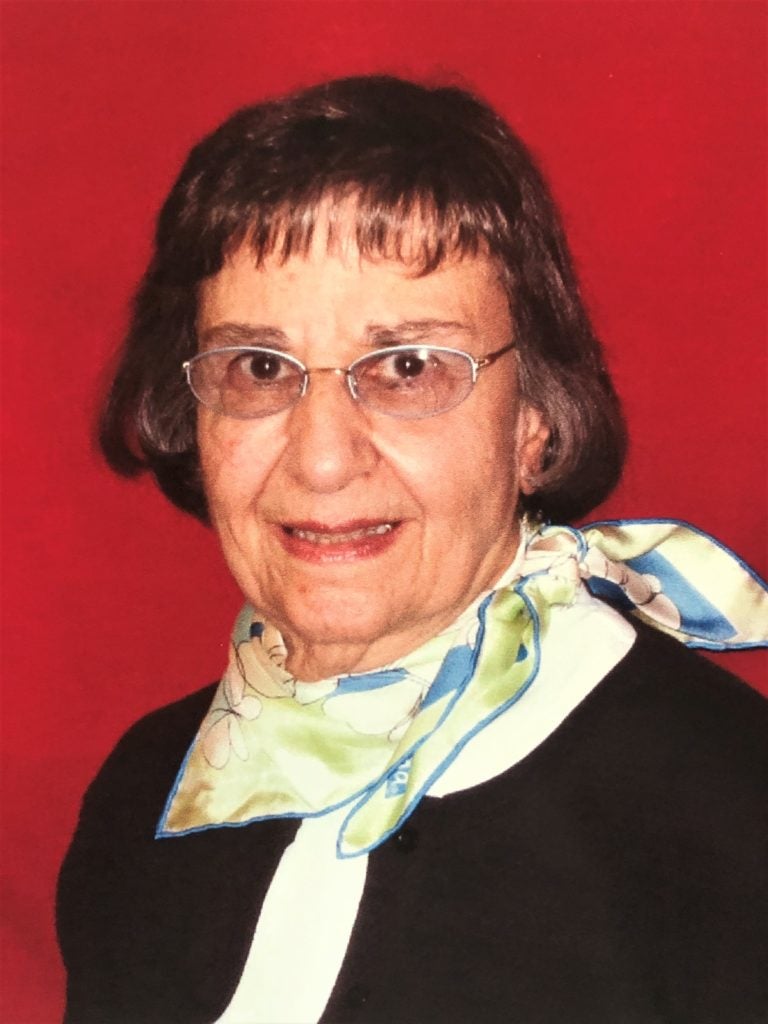More History: ‘Awarded a Place’
Read an article about the history of nursing students in the College of Arts & Sciences, including their admission and registration as College students in the late 1940s.
Read This ArticleMay 7, 2020 – Many years ago, Georgetown nursing alumna Marie (Santora) Bruce (Diploma 1948, BSN 1950) sailed with friends along the Potomac River to enjoy an afternoon at the Three Sisters Island.
Suddenly, the nursing students realized they would never make it back on their own to Georgetown University Hospital in time for their scheduled shift.

From the Georgetown University Archives: A photo of Bruce from the 1948 Caduceus yearbook and the cover of the June 14, 1948 Georgetown University Commencement program. Bruce is listed with the diploma graduates in 1948 and then with the bachelor of science in nursing graduates in the 1950 Commencement program.
Fortunately, assistance arrived that day in the form of the river patrol and other boaters. Soon the students’ boats were being pulled back to the shoreline, Bruce recounted, with a hint of amusement.
Bruce shared memories about her time at Georgetown and her career during recent phone conversations as the COVID-19 outbreak continued to unfold, including social distancing measures.
In fact, part of her long career as a nurse involved infection control and emergency preparedness planning.
But the story about how she became a nurse begins well before that.
Bruce arrived at Georgetown 75 years ago this coming September to enroll as a student in the hospital’s Cadet Nurse Corps, which involved about three years of study in nursing, which she did from 1945-1948. Most of her classmates were in the Corps, she said.
(According to histories written by Dr. Robert Emmett Curran and Dr. Alma Woolley and a 1944-1945 nursing brochure in the Georgetown Archives, the Corps, a federal effort formed during World War II, financially supported the education of nurses for practice in both civilian and military settings. The brochure read, “The Cadet on graduation is eligible to become a registered nurse or in some cases to continue on to her degree of Bachelor of Science in Nursing.”)
Bruce’s leadership skills had become evident in high school at Ursuline Academy in Maryland. “[My classmates] elected me president every year because I didn’t mind speaking up,” she said.
Now 92, the retired nurse manager remembered taking her entrance examinations, as well as her interview with Anne M. Murphy, director of Georgetown’s School of Nursing from 1945-1947. “She was very much a part of our lives,” Bruce said. “I liked her. She knew how to get things done.”
Bruce noted the nursing students studied hard, worked long days, and did a great deal around the hospital. “Every procedure we learned, we had to demonstrate, and a supervisor had to sign off on it. . . . We were taught to do everything.”
The initial part of the diploma program involved classwork, but then students began hospital shifts – which ran all day and night in three eight-hour time blocks – while also managing to take their courses.

Read an article about the history of nursing students in the College of Arts & Sciences, including their admission and registration as College students in the late 1940s.
Read This ArticleThey spent about a month in each clinical area, including in the medical and surgical units, OB/GYN, and the nursery.
The program included three-month clinical affiliations at Children’s Hospital and the Seton Psychiatric Institute. At Children’s, Bruce worked in several units including the polio ward. At Seton, she worked on the “open ward.” She and her classmates also “learned to play bridge” while on breaks at Seton.
Back at Georgetown, among her many responsibilities, Bruce served as a “scrub nurse,” assisting the surgeon with the instruments in the operating room.
Indeed, she says, “We were busy every minute.” Cleaning and sanitizing surgical equipment. Washing surgical gloves. And climbing on a ladder to wipe down the walls of the operating room.
And, in downtime, she and friends might head to Teehan’s, a little restaurant near campus. “We didn’t have any money,” she said. “We’d go over and order a Coke or something. And a lot of times, Mr. Teehan would give us a free one.”
Noting how different rules were from today, she added: “We were allowed to be out until 10 o’clock on a Friday or Saturday night. A late leave of 11:30 must be requested in writing, and the housemother would check you in.”
After graduating in 1948, Bruce applied to Georgetown’s College of Arts and Sciences in order to earn a bachelor of science in nursing, which she completed in 1950.
During the College years, Bruce said that she and a small number of other women took a few classes on campus with the men. “All the boys could not believe we were in class with them,” Bruce remembered. “They looked kind of surprised.”
Bruce worked two nights a week as a nurse at Georgetown while completing the College portion of her education. Immediately upon graduation, she was offered a management position as head nurse on 5 East of the hospital, a busy area that included medicine, the diagnostic referral clinic and, later, neurology.
This role brought her into contact with some of the university’s well-known physicians, including renowned neurologist Dr. Francis M. Forster and Dr. Charles A. Hufnagel, who invented the artificial heart valve.
“He was wonderful, and he was so humble,” recalled Bruce, who recounted stories about Hufnagel’s kindness. One involved a young boy from Canada who suddenly realized he might not have enough money to pay for his surgery the next day.
“Don’t worry,” Bruce remembered Hufnagel saying upon hearing the child’s story, “I’ll do the surgery for nothing.”
She also enjoyed working with Sister Charles Ambrose, of the Sisters of Charity of Nazareth. The unit supervisor from Kentucky shared with Bruce her recipes for mint juleps and bourbon balls. They stayed friends until the sister passed away.
About that time in her career, she warmly shared: “We were kind of like a family. Everyone looked out for each other.”
After leaving the university’s hospital, she and her husband James K. Bruce, a 1942 Georgetown graduate who served in the U.S. Navy, moved to Rockville.

Bruce during the time she was working at Montgomery General
She spent time raising their two children, Anne and Mary Frances, before reentering the workforce at Montgomery General Hospital in Maryland. (Anne graduated from Georgetown in 1982 with a bachelor’s degree in economics.)
Bruce was named the hospital’s first safety officer. Per Joint Commission standards, she developed and taught the safety management program. With the permission of the president of the hospital, Bruce developed the emergency preparedness policy and shared it with presidents of the hospitals in the county.
“The Army sent an officer across country to check on the emergency preparedness plans,” Bruce said. “He liked our ideas and took a copy of the plan.”
Bruce also managed employee health and served on the infection control committee. She brought learning opportunities to the hospital, including inviting an expert from the National Institutes of Health to help educate the infectious disease team about HIV/AIDS and the hepatitis B vaccine.
Additionally, she launched the “Freedom from Smoking Program,” an effort to discourage cigarette smoking in the hospital.
In 1980, the Bruces’ daughter Mary Frances passed away at the age of 18 from a heart condition. At this time, to help distract from her grief, Bruce decided to go back for her master’s degree in nursing, which she did between 1980-1986 at George Mason University. Courses, which she attended after work, ran twice each week between 4-7 PM. When she graduated, she and classmates were inducted into Sigma Theta Tau, the international honor society for nursing.
Bruce said retirement didn’t really suit her personality. “I always wanted everything done immediately. If you can’t do it right, don’t do it at all.”
Up until the COVID-19 outbreak, she continued to use her Georgetown nursing education – a journey she began 75 years ago – to volunteer to take blood pressure weekly at a local senior center in Maryland.
“I’ve always been busy,” Bruce said.
By Bill Cessato
Note: The author is extremely grateful to Marie Bruce for all of her time with this alumna spotlight and her editing prowess, as well as to her family members for their kind assistance with sharing story drafts and the photograph.